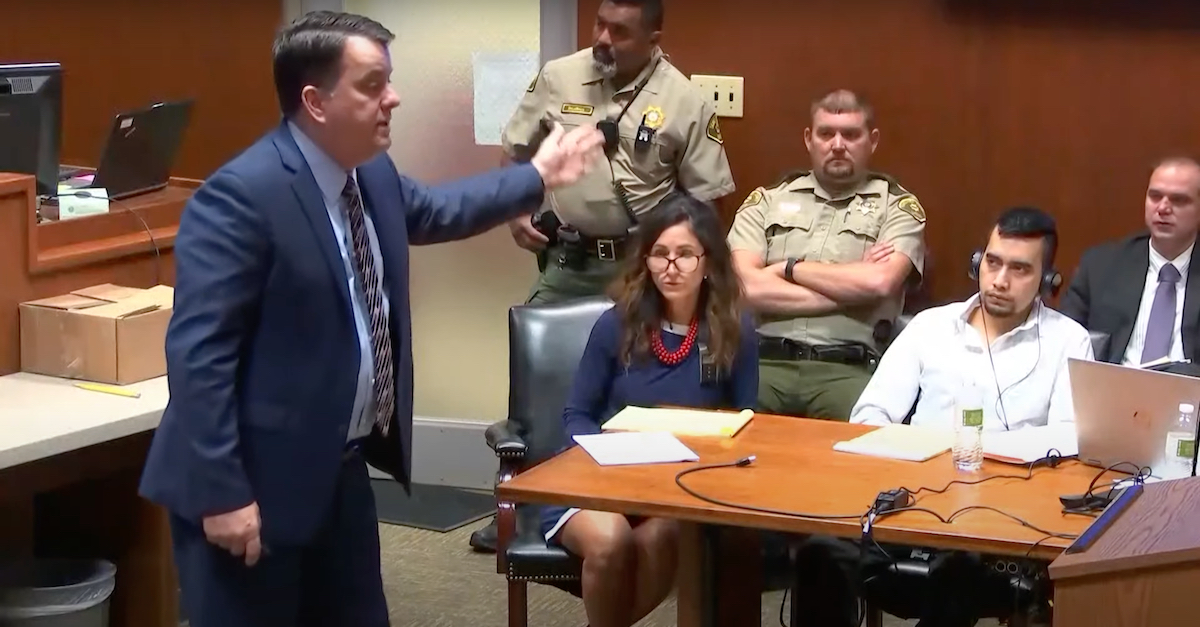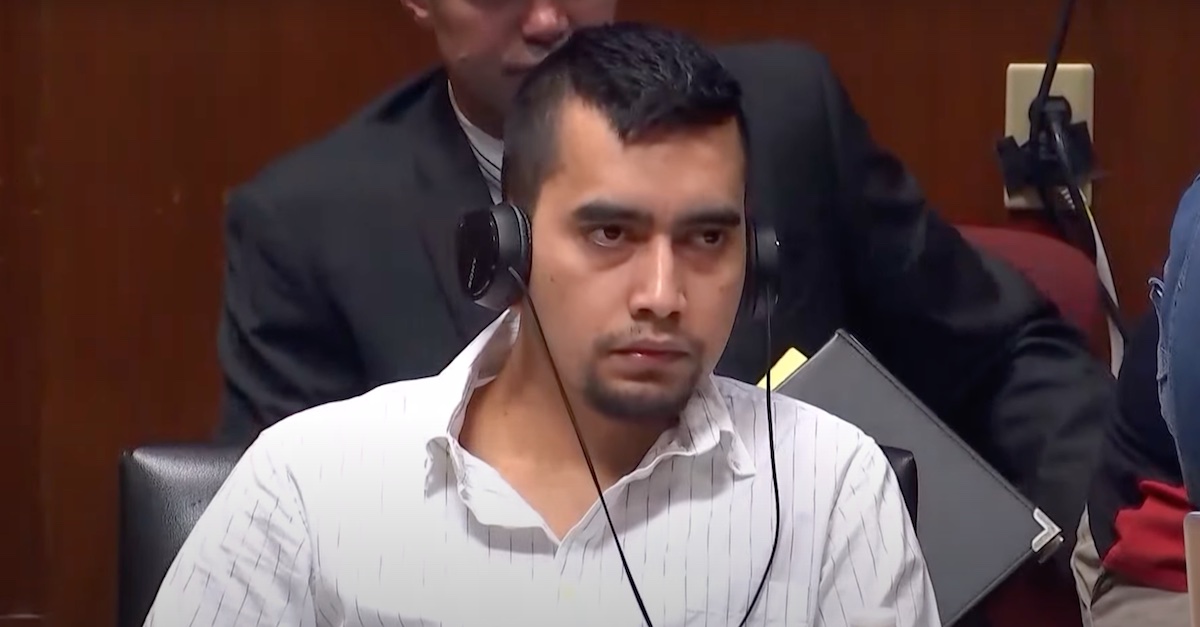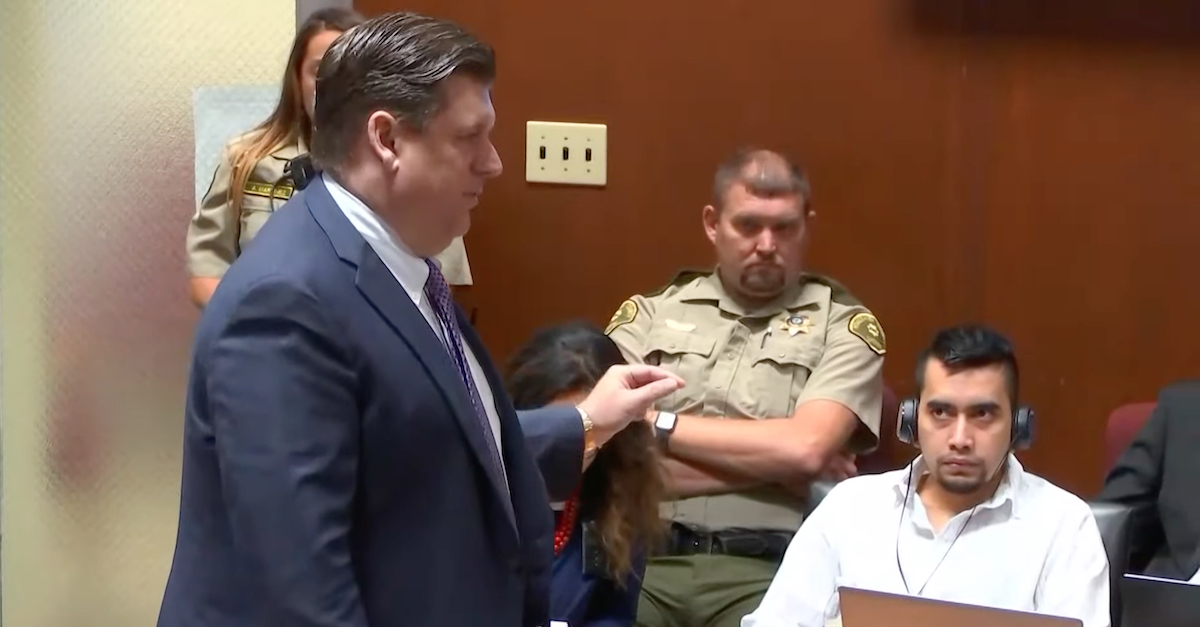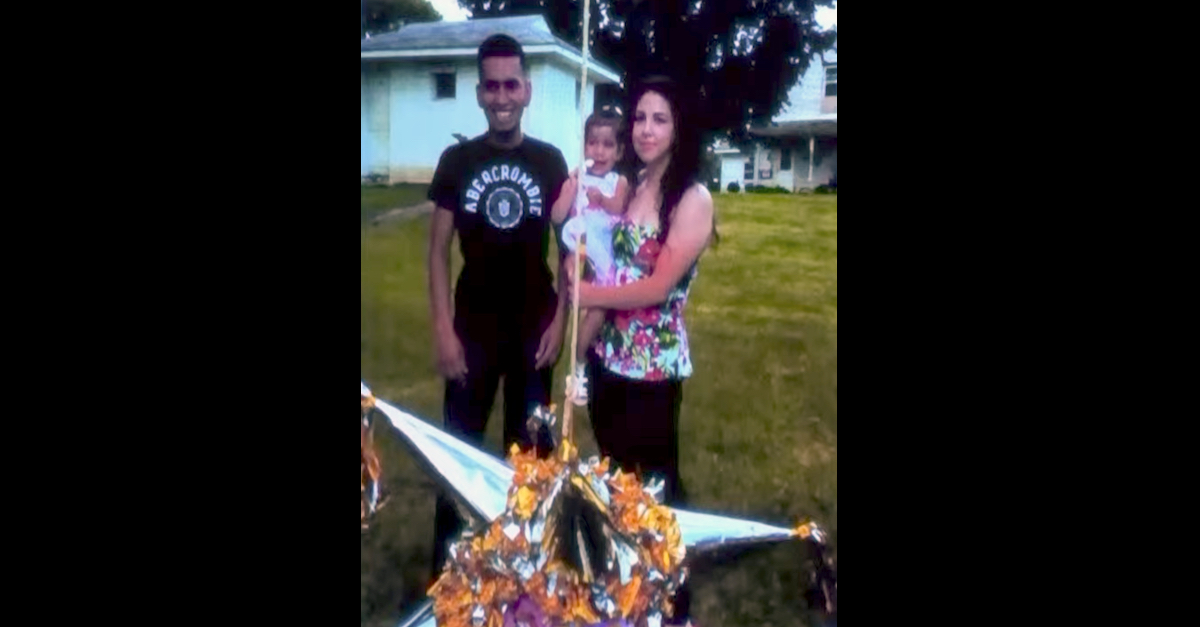
Prosecutors showed this image of victim Mollie Tibbetts during closing arguments.
Prosecutors and defense attorneys presented wildly different versions of what happened when Iowa college student Mollie Tibbetts, 20, was murdered in 2018. Prosecutors painted the defendant, Cristhian Bahena Rivera, as a killer who suddenly targeted Tibbetts after spotting her jogging. The state said the defendant exploded in a fit of violent rage when Tibbetts rebuffed his advances — even slapping him and saying she would call the police. The defense pointed to unknown male DNA in a blood sample recovered from the trunk of the defendant’s car “mixed with” Mollie Tibbetts’ DNA. The defense said that indicates that other killers were involved, just as Bahena Rivera testified. The defense further pointed to inconsistent statements by Dalton Jack, Tibbetts’ then-boyfriend, and sloppy police work as grounds for reasonable doubt.
The Prosecution
“You’ve heard a case and evidence about a young woman who went for a run on July 18 of 2018, and she never came home,” said prosecutor Scott Brown. “Her life was brutally taken by the defendant on July 18th of 2018.”
Brown showed portraits of Tibbetts and said she was just starting her adult life.
“She was confronted by this man,” Brown said while pointing to the defendant. “She crossed paths with him, and it ended her life. She was attacked brutally by him. She was stabbed repeatedly by him.”

Prosecutor Scott Brown points at the defendant during closing arguments.
He continued:
Can you imagine what that was like for her? Nine to twelve times she was stabbed. Her clothing was removed; she was dumped into a cornfield — discarded under a pile of corn. She was covered with those leaves and she was left. Five weeks Mollie’s body laid in that corn field. And you know who knew about that? One man. One man knew, and he is here. His name is Cristhian Bahena Rivera. The evidence in this case shows that the defendant and only the defendant murdered Mollie Tibbetts. All of the credible evidence in this case — all of it. There weren’t two other guys. That’s a figment of his imagination. All of the credible evidence in this case — all of it! — points at hime. All of it.
Later, Brown argued that Bahena Rivera targeted Tibbetts because of the way she looked:
You can look at the picture of Mollie Tibbetts. She is a cute 20-year-old woman. He likes her. He sees her. She’s in tight clothing as she’s jogging; she’s in a jogging bra and Spandex tight shorts as she’s driving down the road. That’s what got his attention. That should be patently obvious.
Brown repeatedly dismissed Bahena Rivera’s suggestion that two unknown men forced him to drive to locate a “runner,” that one of those men got out of the car after, walked down the road, returned ten to twelve minutes later, and forced him to drive to a location where the men put Tibbetts’ body in his trunk. Bahena Rivera then claimed the men told him to drive to the location where he dumped Tibbetts’ body after the men disappeared.
“All of a sudden, now, we have these two men,” Brown said. “He gets up and gives us this different version of what happened. You know what the problem is with it? It doesn’t make sense, and it doesn’t fit.”

Cristhian Bahena Rivera listens to the prosecution’s closing argument.
“The video evidence here refutes his testimony,” Brown continued while pointing to a neighbor’s surveillance video which appears to show Tibbetts running and the defendant’s car passing several times in short succession. “He said that he and two men passed her running going into town, right? Out on 385th. They were going into town whenever she was running. That’s when he said they saw her. The video shows the defendant on East Des Moines seconds after she passes through. Not out on the county road. Whoops! He didn’t think about that. Right? We’ve got him in town in his vehicle whenever she passes by within thirty seconds. Think about. Right after she passes by there is no way he could have passed her on the outskirts of town and seen her for the first time. He saw her for the first time whenever he saw her in town. That’s what the video shows. He cannot be in two places at once.”
Brown implored jurors to “scrutinize” Bahena Rivera’s testimony. “It doesn’t fit with that video.”
“The evidence in this case is that he stabbed her to death,” Brown said earlier. “When the defendant was interviewed, he confessed. He told [Officer] Pamela Romero what he did, or at least those parts he claimed he could remember.”
Brown also noted that Tibbetts’ blood was in the trunk of defendant’s car. He said the only “coherent story” about what happed proves “beyond a reasonable doubt that the defendant is guilty.”
Part of the presentation included a slide containing Iowa murder law.

Brown said there was “really no doubt about” elements two, three, and four of Iowa’s murder statute. Even though motive is not one of the elements of the crime, Brown suggested that “anger” was the motive for the killing.
“Mollie rebukes him,” Brown said. “Mollie is threatening to call the police, and the defendant was angry. He says that. He tells us that . . . the way he reacts to that anger is to stab this young woman to death and dump her body into a corn field.”
Elsewhere, Brown reminded the jury that Bahena Rivera told the police that Tibbetts slapped back in an attempt to defend herself.
The prosecutor said the police ran down leads on a list of at least six alternate suspects the defense said were not property vetted by the police. Brown said the police followed the evidence and arrived at the correct suspect.
“He would have plunged a knife into her at least nine times,” Brown said while arguing that the defendant acted with malice aforethought. “Sharp force injuries to her neck and to her chest, which kill her. If that’s not malice aforethought, I’m not sure what is.”
“There’s no other intent here other than specific intent to kill,” Brown argued while referencing the fourth element required under Iowa murder law. “There’s premeditation, there’s willfulness, and there’s deliberation. He tracked her down, he found her on the road, he got angry, and he stabbed her to death and he dumped her body. That’s what the evidence is in this case.”
The Defense
Defense attorney Chad Frese said Mollie Tibbetts was a “spectacular young woman” who was an “absolutely innocent victim.”
“She was just about to spread her wings and fly,” Frese continued. “We acknowledge that. We sympathize with her family; we offer empathy to them.”
Then he told the jury to ignore those emotions:
That can be a problem when you are sitting as a juror because when you’re sitting as a juror, emotions have no place in that deliberation room. You don’t decide this case based upon emotions. You don’t decide this case with emotions tugging at your heart strings. It’s not your job to right a wrong. It’s not your job to impart vengeance. It’s not your job to bring justice for Mollie. She deserves justice, absolutely, but that’s not your job. Your job is to do justice. Period. Full stop. Your job is to provide a logical, analytical, almost surgical and mechanical application of what you heard here and in the instructions, and that’s it. The analysis is simple. The analysis is not whether you go back in that room and decide, ‘I think he did it.’ The analysis is much, much different than that. The analysis is whether this table and the people from this table — the government of this State of Iowa and the people hired by the government of this State of Iowa and the resources they have produced — have brought forth enough evidence to prove this case and each and every element of the charge beyond a reasonable doubt. That is a huge standard, folks. That is a high standard. You cannot forget that, and you must keep that in the forefront of your mind. It must be right here all the time. You can’t be swayed by emotion. You can’t let pictures and emotions of those pictures get to you. You must be logical, and you must do your job. Judge Yates has told you that. I’m reminding you of that. I’m not talking at you about it; I’m just cautioning you. Because that’s what justice is. Justice is have they done their job and proven Cristhian Bahena guilty beyond a reasonable doubt.
Frese said Tibbetts’ disappearance became a “circus” involving national news reports, offers of reward money, and promises of “unlimited” resources and assistance from the federal government — including the FBI and the Department of Homeland Security — in a small Iowa town. He called the situation completely “unprecedented” for his state.

Chad Frese delivers his closing argument.
“They had nothing,” Frese said. “Imagine the pressure to close this case. Imagine the pressure to put this case to bed. Because that’s the context in which this arrest and this charge happened.”
Frese then called the investigation “sloppy” — “but they didn’t get enough evidence to prove this case beyond a reasonable doubt.”
Frese admitted that Bahena Rivera was driving the Malibu spotted on a neighbor’s surveillance camera and admitted that Tibbetts’ blood was in the trunk of that car.
“That’s true, too. We aren’t going to dispute that at all,” Frese said — but then noted the blood was a “mixture.”
Frese disagreed that the defendant confessed.
He said a murder weapon, a primary crime scene, eyewitnesses, a motive, a confession, and scientific evidence were all scant or missing.
“Don’t let the state oversimplify,” a slide on a video projector read.
Frese said a home on Des Moines Street contained a gun safe with a number of guns, a loaded pistol, and several hunting knives, including a folding knife.
“I’ll bet you if they would have looked, they may have found one with a camouflaged handle, but they didn’t bother to look. Why? Because they’d already made up their mind.”
Frese then complained that the state never identified a primary crime scene:
They’ll pass it off and explain it away by — oh, it’s been five weeks; the weather was bad; the corn was tall — they’ll find an excuse for everything. That’s not Mr. Bahena’s problem. Okay?That’s their problem. They have to prove it. Not him. Okay? They had the unlimited resources of the federal government. They had drones up in the air. They brought a guy in from Dayton, Ohio, for the sole purpose of analyzing the data from one cell phone . . . they had unlimited resources . . . his sheriff was up flying around in a helicopter, and they can’t even tell you where she was killed.
Frese said it was hard to believe that a 5’7″ tall, 125-pound undocumented immigrant was angry at Mollie Tibbetts for rejecting him. Rivera was not described as a violent man by those who knew him; rather, he was a worker who sent money back to his family in Mexico. Rivera had every reason to lay low, avoid the police, and continue working in the United States under the radar, Frese said.
Frese continued by attacking the defendant’s 11-hour interview. He said the local authorities kept telling Bahena Ravera they weren’t there for immigration purposes until they didn’t get the story they wanted — then they called and put an immigration detainer on the defendant despite saying they wouldn’t do so.
He then attacked former Pamela Romero, the officer who interviewed the defendant.
We saw her up there. Her answers were evasive. She was nonresponsive in many of her answers. She was obviously biased in her answers. She couldn’t say yes or no to an answer; she had to try to explain herself and take it in a different location. She wants to get back into law enforcement even though she’s out of law enforcement. She never done a homicide interview in her career — ever. What a colossal blunder.
Frese said that even if the jury believed the state’s telling of Bahena Rivera’s first story — that the defendant became angry and just started stabbing — he didn’t form the requisite malice or premeditation. He then suggested that all the state could prove was second-degree murder or perhaps a version of manslaughter.
Frese also cricitized the state for failing to produce video of the defendant leading authorities from the sheriff’s office to Tibbetts’ body. He said the state also failed to check phone records from Dalton Jack, Tibbetts’ boyfriend, to attempt to corroborate his story that he was out of town working on a road construction crew when Tibbetts disappeared. Frese said the authorities were “excited” and “cut corners” when they located Bahena Rivera.
The defense then noted that unknown male DNA was discovered mixed with Tibbetts’ DNA on a small spot recovered from the trunk of Bahena Rivera’s car. That, the defense said, was proof someone else was involved. The unknown DNA did not come from the defendant.
Frese said authorities failed to test Jack’s DNA.
Jack also failed to tell the authorities he had an affair on Tibbetts.
“They didn’t test anybody’s DNA other than Cristhian and the Tibbetts family — and all the Hispanics” at the farm where the defendant worked. “Why would you not do that so you at least could exclude people?” Frese asked rhetorically — again noting that the state bragged of having “unlimited resources” to solve the case.
Someone else’s fingerprints were in Rivera’s trunk, Frese said. Comparison cards were so “sloppy,” the defense added, that they were useless — because the police didn’t take them properly.
Frese then circled back to Dalton Jack, whom the defense has long suggested or insinuated could have been involved.
“They knew from the jump that this guy was a problem,” the defense said of prosecutors with reference to Jack. Frese then pointed to Jack’s many “inconsistent statements” about Tibbetts’ disappearance. Frese then cut into Jack’s statements and his character:
Remember? Mr. Jack didn’t even want to be here. Didn’t want to be here for the love of his life to make sure she had justice. What kind of person is that? Well, it’s the same kind of person that would have an affair on the love of his life while he was planning on getting engaged to her. It’s the same kind of person that would portray their relationship as rosy to the public while it was rocky in private. It’s the same kind of person that was losing control of Mollie. She was going to fly. She was outgrowing this man. He was angry; he had a history of being a fighter; and they knew he was a problem. All Dalton Jack had to add was his testimony that he did not do this. And his alibi that the state gave you was his inconsistent statements. No video cameras from the hotel. Not a single receipt that shows that he was at Walmart, or got gas, or went to the gas station, or gotten beer — nothing. No time cards. Cell phone towers? We talked about those. We knew where Ms. Tibbetts was. But we don’t know where Dalton was. Easily found.
Frese then said Jack texted Tibbetts “within ten minutes” of when she was killed.

“Ten minutes later she’s in a trunk going at a high rate of speed away from Brooklyn, Iowa,” Frese said. “Where was that text sent from? Where’s the tower information on that? That’s a suspicious text if I’ve ever seen one, folks. It sounds like someone trying to cover his tracks.”
“But, believe his boss; don’t believe unbiased evidence,” Frese said — mocking the state’s theory of the case.
The defense then noted that Dalton Jack admitted he had anger problems, changed his story about what he was doing the night Tibbetts disappeared, and admitted he changed his story about whether or not his relationship with Tibbetts was rocky.
Jack has denied involvement in Tibbetts’ disappearance and death.
Ron Pexa, another individual the defense has zeroed in on, was a former cop who lived near the location where Tibbetts’ body was dumped, Frese continued. Separate tipsters told police he was a “sexual deviant” and “maniac” with a “torture room,” Frese said, but the defense noted the police only had a cursory conversation with Pexa.
“He’s taking care of his own,” Frese said of the officer who spoke to Pexa. “Ron Pexa’s a cop. Cristhian Bahena’s statement was taking care of his own. He was protecting his daughter and his daughter’s mother.”
Frese said the defense didn’t know all of the details but that the location where Tibbetts was dumped was not a “coincidence.”
Frese suggested that the jury cannot hold Bahena Rivera’s inconsistencies against him while crediting the inconsistencies of others who testified.

Cristhian Bahena Rivera’s family.
Frese then showed a picture of the defendant while referencing character testimony that suggested Bahena Rivera was not a violent person.
“You must acquit him,” Frese said. “That man right there is the one you have to judge.”
“What the police did is they had four weeks worth of nothing, and then they picked this man. And who better to pick than an undocumented immigrant who doesn’t speak the language who has nobody here to speak of to help him out, and then you cherry pick the facts that fit your theory and you close the case. Case closed. But the case is not solved. Folks, there is serious doubt in this case. Serious doubt. Cristhian Bahena Rivera has not had the case against him proven beyond a reasonable doubt, and the only verdict you can come up with under these facts and what you heard right there is not guilty.”
Prosecutors then presented a rebuttal.
[Images via the Law&Crime Network]
Have a tip we should know? [email protected]